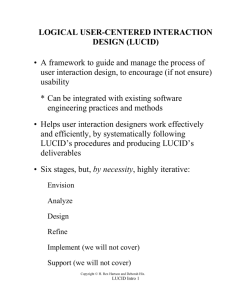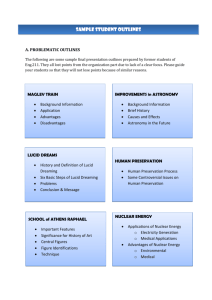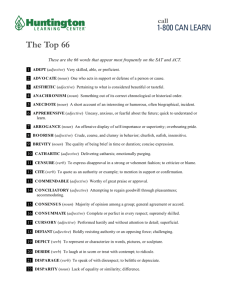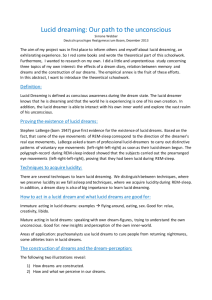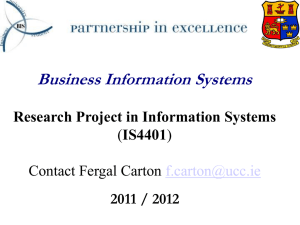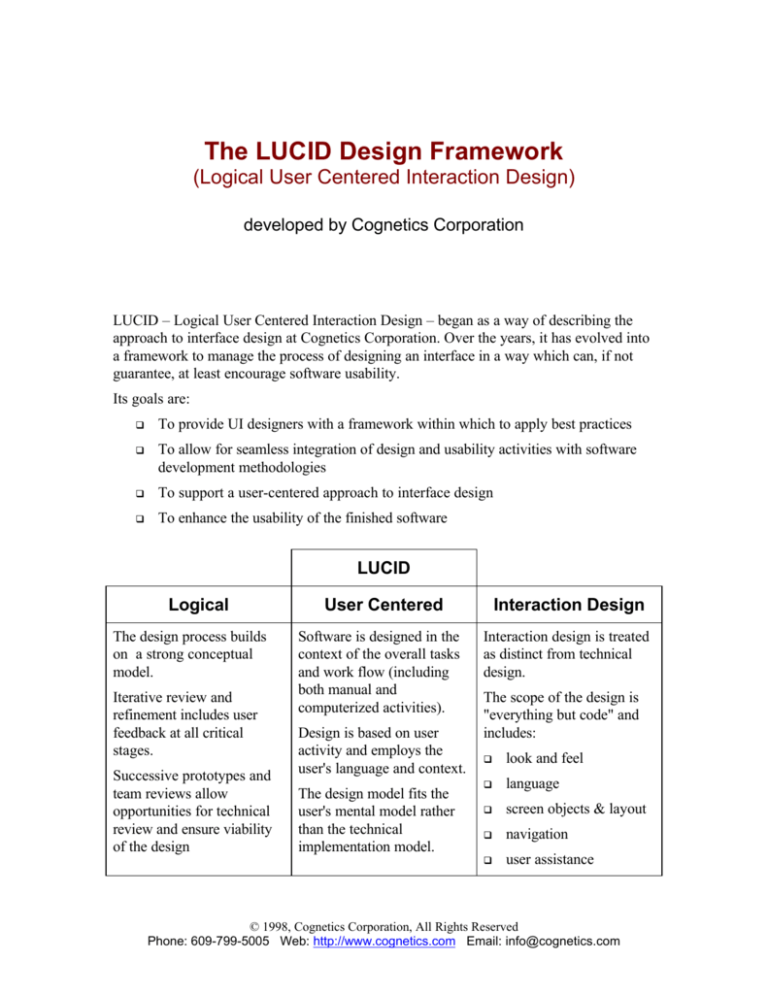
The LUCID Design Framework
(Logical User Centered Interaction Design)
developed by Cognetics Corporation
LUCID – Logical User Centered Interaction Design – began as a way of describing the
approach to interface design at Cognetics Corporation. Over the years, it has evolved into
a framework to manage the process of designing an interface in a way which can, if not
guarantee, at least encourage software usability.
Its goals are:
q
To provide UI designers with a framework within which to apply best practices
q
To allow for seamless integration of design and usability activities with software
development methodologies
q
To support a user-centered approach to interface design
q
To enhance the usability of the finished software
LUCID
Logical
The design process builds
on a strong conceptual
model.
Iterative review and
refinement includes user
feedback at all critical
stages.
Successive prototypes and
team reviews allow
opportunities for technical
review and ensure viability
of the design
User Centered
Software is designed in the
context of the overall tasks
and work flow (including
both manual and
computerized activities).
Design is based on user
activity and employs the
user's language and context.
The design model fits the
user's mental model rather
than the technical
implementation model.
Interaction Design
Interaction design is treated
as distinct from technical
design.
The scope of the design is
"everything but code" and
includes:
q
look and feel
q
language
q
screen objects & layout
q
navigation
q
user assistance
© 1998, Cognetics Corporation, All Rights Reserved
Phone: 609-799-5005 Web: http://www.cognetics.com Email: info@cognetics.com
An Introduction to the LUCID Framework
Page 2
Over the past 30 years, several techniques for managing software development projects
have been developed and documented. While these techniques have helped large software
development projects meet time, budget, and quality goals, they do not directly address
usability issues. Because most systems being developed today are interactive, software
development methodology must be expanded to include the design of the user interface.
The LUCID Framework was developed to fill this need. It is a methodology for designing
the interactional components or “front end” of a software product. The LUCID
Framework can be integrated with other software engineering methodologies or, for small
product development efforts, can be used as a stand-alone methodology.
LUCID is organized into six stages:
Stage 1:
Envision
Develop UI Roadmap which defines the product
concept, rationale, constraints and design
objectives.
Stage 2:
Analyze
Analyze the user needs and develop
requirements.
Stage 3:
Design
Create a design concept and implement a key
screen prototype.
Stage 4:
Refine
Test the prototype for design problems and
iteratively refine and expand the design.
Stage 5:
Implement
Support implementation of the product making
late stage design changes where required.
Develop user support components.
Stage 6:
Support
Provide roll-out support as the product is
deployed and gather data for next version.
Each of these stages is completed in sequence building the elements of the interface until
the design is complete. Many of the tasks within a stage are iterative – repeated in a rapid
cycle with review tasks until the result is a satisfactory conclusion. In addition, key
documents such as the UI Roadmap and the requirements analysis are reviewed at the end
of the design stages to ensure both that any new information is incorporated and that the
design work has stayed within the scope outlined in them.
Copyright 1998, Cognetics Corporation, All Rights Reserved
DRAFT PRE-PRINT. DO NOT COPY OR DISTRIBUTE WITHOUT PERMISSION
An Introduction to the LUCID Framework
Page 3
LUCID Stage 1: Envision
The purpose of LUCID Stage 1 is to create a clear, shared vision of the product. This vision is
described in the UI Roadmap—a comprehensive high-level document that communicates the design
vision, manages expectations, and serves as the basis for evaluating progress throughout the
project.
It is difficult to overstate the importance of developing the product concept at the beginning of the
project. Although a remarkable number of development projects proceed without a clear product
concept, this inevitably leads to serious problems later in development. In addition to
communicating the product concept to interested parties, the UI Roadmap is used to guide decision
making and evaluate progress throughout the design project.
Goals
q
q
q
q
q
q
Prerequisites
q
q
q
q
Decisions
create a concise description of the product
identify the business and design objectives that will shape the design
identify constraints on the product
identify the target user population
identify the main functionality of the product
create screen sketches that demonstrate the product concept
A need has been identified.
The design group has been assembled.
There is corporate support for the project.
The basic technical environment has been identified.
1. How will the design group solicit user input? For example, you may bring
in users, utilize ‘surrogate users’ (typically someone within your
organization who once was a user), or perform field surveys.
2. During Stage 1, you may decide that the design group is missing some
desirable skill or type of knowledge. Make sure the design group is
appropriate for the project, and reconfigure the group if necessary.
3. Based on the UI Roadmap created at the end of Stage 1, you may need to
rethink the project. Possibilities include expanding, shifting, or reducing
the scope based on time, budget, or technical constraints.
Tasks
Task 1.1 Create a High Concept Statement for the product
Task 1.2 Identify the business objectives the product will
serve
Task 1.3 Identify the user population
Task 1.4 Identify usability goals
Task 1.5 Identify high-level constraints
Task 1.6 Identify high-level functionality
Task 1.7 Produce screen sketches
Task 1.8 Create the project plan
Task 1.9 Create the UI Roadmap
Deliverables
The primary deliverable of LUCID Stage 1 is the UI Roadmap, a
comprehensive high-level description of the product.
Copyright 1998, Cognetics Corporation, All Rights Reserved
DRAFT PRE-PRINT. DO NOT COPY OR DISTRIBUTE WITHOUT PERMISSION
An Introduction to the LUCID Framework
Page 4
LUCID Stage 2: Analyze
In LUCID Stage 2, members of the design group work with representatives of the user community
to document work processes and identify specific needs. This information is used to produce the
requirements analysis.
Because the design team must understand the setting in which the product will be used, LUCID
Stage 2 begins with a review of the environment in which the product will be used. Next, the users
are divided into groups with similar needs and a data-gathering plan is developed. Then, after data
has been gathered, it is used to describe the work flow. Various methodologies may be used to
extract functionality requirements from the work flow.
Goals
The primary goal of Stage 2 is to uncover the underlying workflow process
and develop a set of objects to represent it. In order to do this, the design team
must first understand the requirements in job-related (rather than technical)
terms, and then identify key objects that will be used to display, manipulate, or
store data.
Prerequisites
q
LUCID Stage 1 has been completed.
q
The high product concept statement, business objectives, user population,
usability goals, and high level functionality and constraints have been
defined and documented.
q
Preliminary screen sketches have been created.
Decisions
1. How will you gather data? Will you visit customer sites, bring customers
in, arrange focus groups, perform observations, or interview user
surrogates?
2. Will re-engineering be considered during Stage 2? Your organization may
mandate that it be included in the development process, and some minor reengineering can be incorporated in the LUCID Design Framework.
However, major re-engineering should be separated from user interface
design.
3. How will you analyze the data to document the work flow?
4. How will you extract the functional requirements from the work flow?
Tasks
Task 2.1 Team preparation
Task 2.2 Segment the user population
Task 2.3 Create a plan for gathering data
Task 2.4 Gather data
Task 2.5 Review and organize data
Task 2.6 Document the work flow
Task 2.7 Extract functionality and requirements
Task 2.8 Create the requirements analysis
Deliverables
The primary deliverable of LUCID Stage 2 is the requirements analysis.
Copyright 1998, Cognetics Corporation, All Rights Reserved
DRAFT PRE-PRINT. DO NOT COPY OR DISTRIBUTE WITHOUT PERMISSION
An Introduction to the LUCID Framework
Page 5
LUCID Stage 3: Design
In LUCID Stage 3,the product’s basic design, including overall navigation, screen layout and
visual design and information or work-flow organization, is defined. The design is iterated through
user and expert reviews until the team is satisfied that the design concept meets usability goals and
is strong enough to be used for complete UI design specifications.
Goals
The key goal of Stage 3 is the development of the key screen prototype, which
will be used as the basis for the interface design specifications in Stage Task 4.
The key screen prototype demonstrates the software’s basic navigation and
‘look and feel,’ as well as screen layout and critical screen objects. The key
screen prototype typically includes the entry to the program; the basic home
screen; major branches off the home screen; and examples of screen objects
used to collect, manipulate or present data.
Prerequisites
LUCID Stages 1 and 2 have been completed.
Decisions
1. Will the product include a conceptual metaphor? While a conceptual model
is required, a metaphor is optional.
2. Do you want to investigate several different design alternatives and/or
‘looks’ before creating the key screen prototype? Low fidelity paper
prototypes can be used to compare several different approaches before
making the selection for the key screen prototype.
3. What type of prototype will be created initially? At the end of this Stage?
Three basic types are possible: low fidelity paper prototypes; medium
fidelity on-screen prototypes; and high fidelity on-screen prototypes.
4. What methods will you use to obtain feedback on the prototype(s)?
Possibilities include demonstration/user review, expert evaluation, and
usability testing.
Tasks
Task 3.1 Develop the conceptual model and metaphor (if used)
Task 3.2 Develop and test the design concept
Task 3.3 Develop a low-fidelity prototype
Task 3.4 Conduct informal usability tests
Task 3.5 Develop a visual design
Task 3.6 Test the visual design (optional)
Task 3.7 Create the key screen prototype
Task 3.8 Usability test the key screen prototype
Task 3.9 Review the UI Roadmap, Product Concept and Requirements
Analysis and revise them if necessary
Deliverables
The primary deliverable of LUCID Stage 3 is a key screen prototype that
demonstrates the basic design of the software product.
Copyright 1998, Cognetics Corporation, All Rights Reserved
DRAFT PRE-PRINT. DO NOT COPY OR DISTRIBUTE WITHOUT PERMISSION
An Introduction to the LUCID Framework
Page 6
Stage 4: Refine
In LUCID Stage 4, iterative refinement is used to transform the prototype into a complete
specification. Two processes are used to expand the prototype: elements that were not fully
detailed are fleshed out, and designs are added for functions that were not originally included. As
new elements are added to the prototype, additional heuristic reviews and/or usability tests are
conducted.
Goals
The key goal of Stage 4 is to complete the development of the prototype and
create the specifications for the interface design, which the developers can use
to implement the program.
Prerequisites
LUCID Stage 3 key screen prototype has been completed.
Decisions
1. Will the key screen prototype be completely developed into a full working
model of the interface, or will only representative screens be created?
2. Will the specifications be complete before “back end” programming
begins? If not, how will the team ensure that the systems design will
support the complete interface?
3. How will new design elements be tested during this stage?
4. Will there be a final usability test of the prototype, or will usability testing
of the general interface be done on early versions of the completed
software (during Stage 5)?
5. How formal will the design specifications be?
6. Will the style guide be developed for this application or also be used for
other interface designs?
Tasks
Task 4.1 Complete the design for all functionality
Task 4.2 Review and evaluate the expanded prototype
Task 4.3 Create an interface style guide
Task 4.4 Create formal design specifications
Deliverables
The primary deliverables of LUCID Stage 4 are a working model of the user
interface, a style guide, and the interface design specification
Copyright 1998, Cognetics Corporation, All Rights Reserved
DRAFT PRE-PRINT. DO NOT COPY OR DISTRIBUTE WITHOUT PERMISSION
An Introduction to the LUCID Framework
Page 7
LUCID Stage 5: Implement
Once the design specification created in Stage 4 is passed to the programming team, the technical
development process begins to take precedence. However, the design team continues to play a role
in the development process, addressing design changes mandated by unexpected technical problems
as they occur.
In addition, the installation procedures must be designed and tested. Another parallel development
effort is that of creating on-line help, user documentation, and any required tutorials. Whether the
design team itself works on the creation of these elements, or coordinates with user assistance
specialists, these elements can be critical to the user acceptance of the program and should not be
overlooked.
Goals
The goal Stage 5 is to make any design changes required by unexpected
technical problems, and monitor the development work for usability problems
which may be introduced. Simultaneously, the designers support the
development of user support materials such as on-line help and tutorials, and
of the installation program.
Prerequisites
The design and specifications are complete and have been delivered to the
programming team.
Decisions
1. What changes during implementation require user review, and how will
that review be carried out?
2. How will the installation program be tested?
3. Is a final user test of the “out of the box” experience required, and how
will it be conducted?
4. How will user assistance materials be tested?
Tasks
Task 5.1 Manage late stage change
Task 5.2 Develop and test user assistance components
Task 5.3 Design and test the installation program or procedure
Task 5.4 Test the “out of box” user experience (optional)
Deliverables
The primary deliverables of LUCID Stage 5 are programming team support,
the design of the installation program and the participation in the development
of the required user support elements.
Copyright 1998, Cognetics Corporation, All Rights Reserved
DRAFT PRE-PRINT. DO NOT COPY OR DISTRIBUTE WITHOUT PERMISSION
An Introduction to the LUCID Framework
Page 8
LUCID Stage 6: Support
In LUCID Stage 6, the new product is released to the user community. This phase, often
unplanned, is critical to the acceptance of the product.
Although the design team may feel that their work is complete once the product and supporting
materials have has been created, usability support is critical during Stage 6.
Goals
The key goal of Stage 6 is the successful introduction of the new product into
the workplace or marketplace.
Prerequisites
LUCID Stages 1-5 have been completed, and the product has been created by
the programming team.
Decisions:
1. How will the product be introduced to users or the market?
2. Is the next version of the product already planned? If so, what information
must be gathered from users of this version to prepare for that release?
Tasks
Task 6.1 Develop a release plan
Task 6.2 Evaluate the product and prepare for the next version
Deliverables
The deliverables for Stage 6 are a release plan, an assessment of user
satisfaction with the product, and a list of usability issues that should be
addressed in future versions.
Acknowledgments
The LUCID Design Framework was developed at Cognetics Corporation under the leadership of Dr.
Charles Kreitzberg. Many people contributed to its development including Whitney Quesenbery, Scott
Gilkeson and Janis Morariu. Inspiration also came from friends of Cognetics, including Dr. Ben
Shneiderman, whose book Designing the User Interface (3rd Edition, Addison, Wesley, Longman, 1998)
has been a constant companion.
Copyright 1998, Cognetics Corporation, All Rights Reserved
DRAFT PRE-PRINT. DO NOT COPY OR DISTRIBUTE WITHOUT PERMISSION

